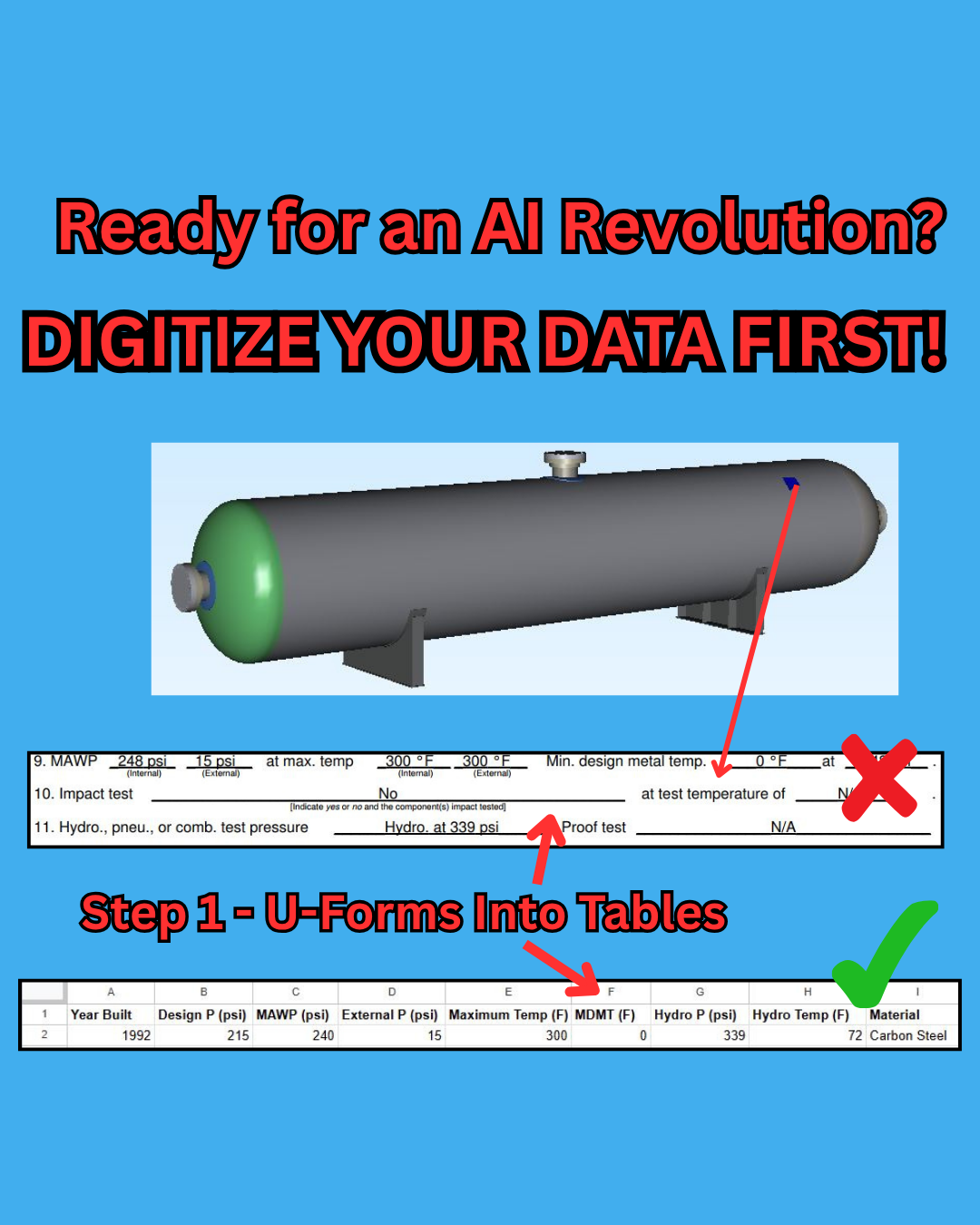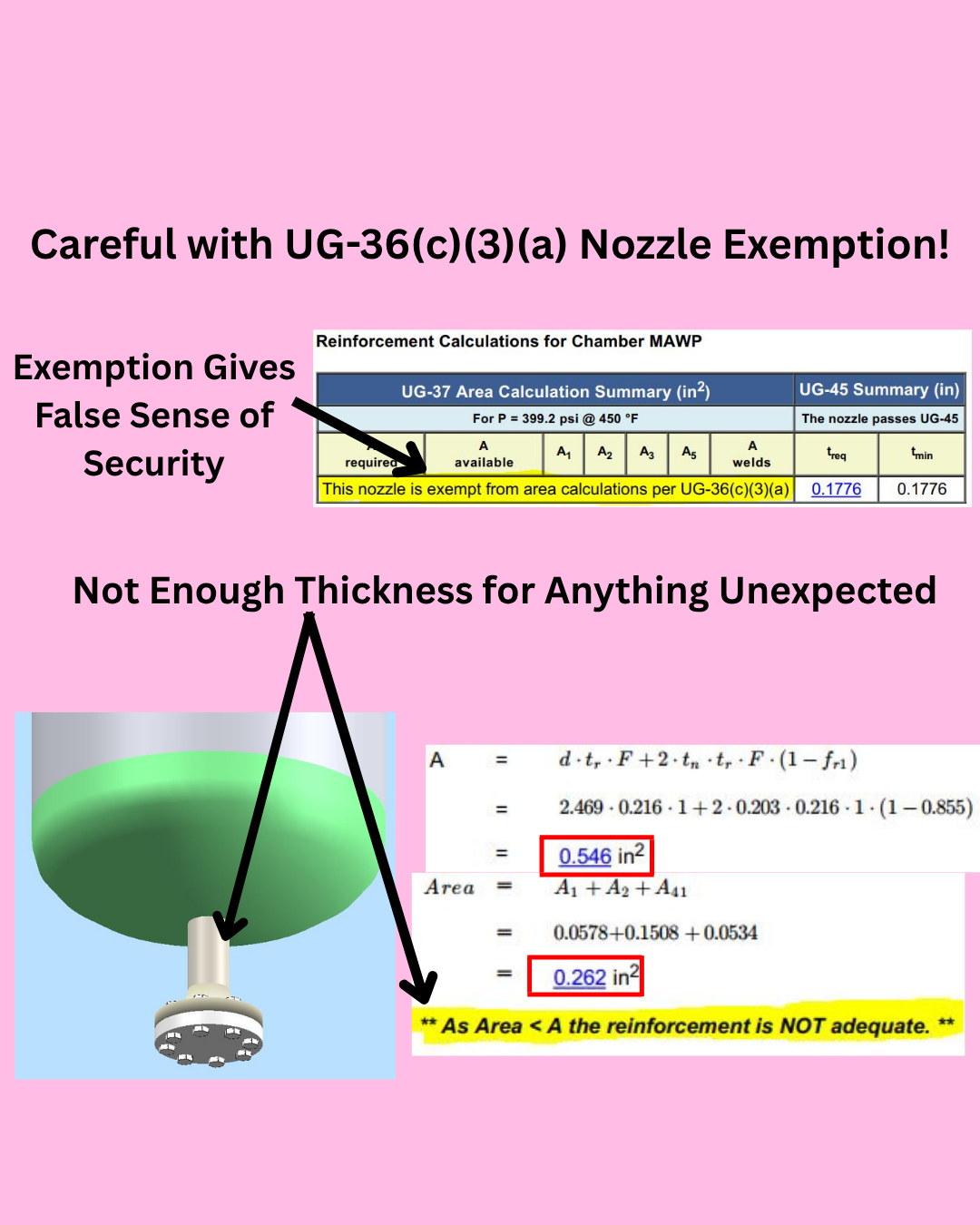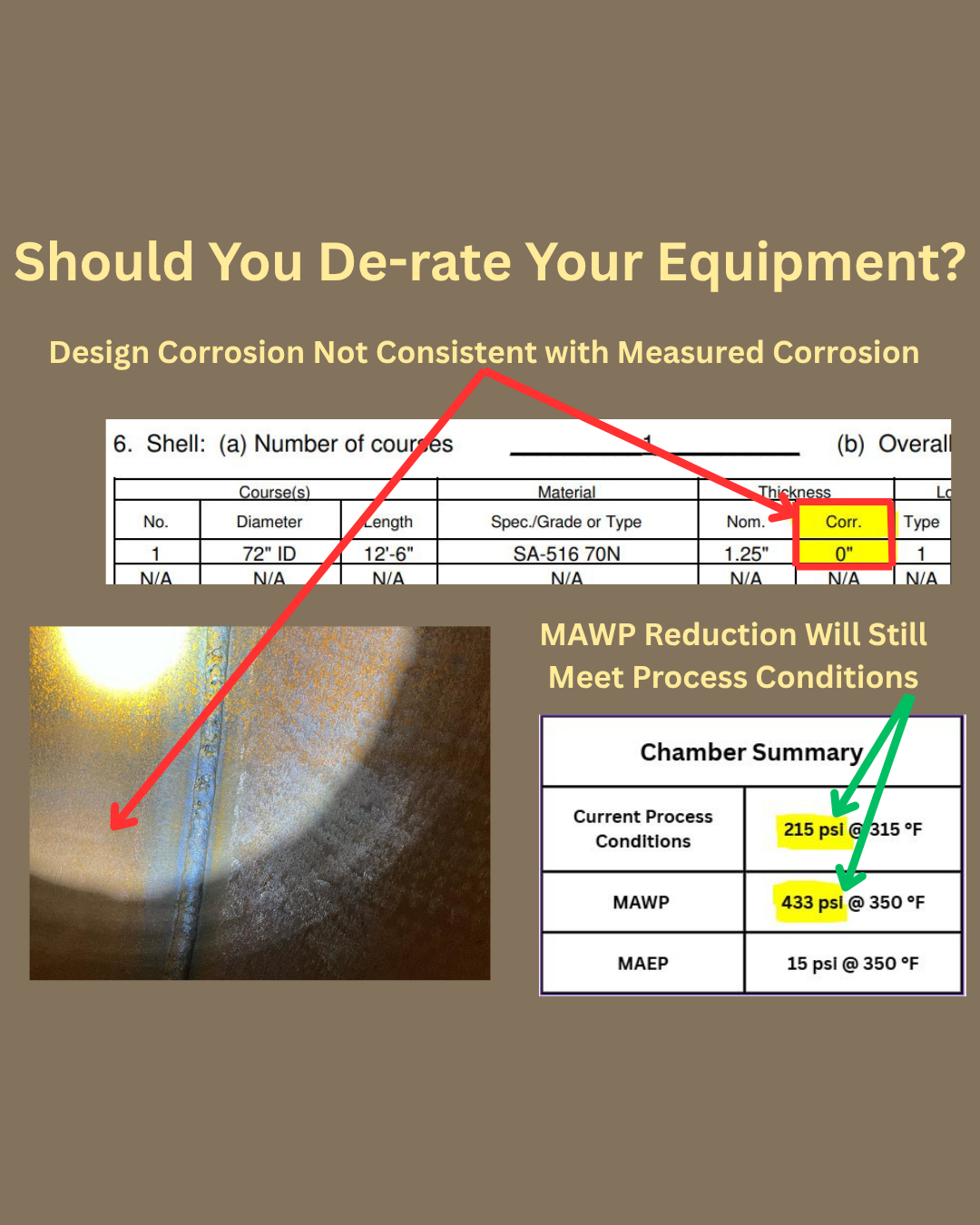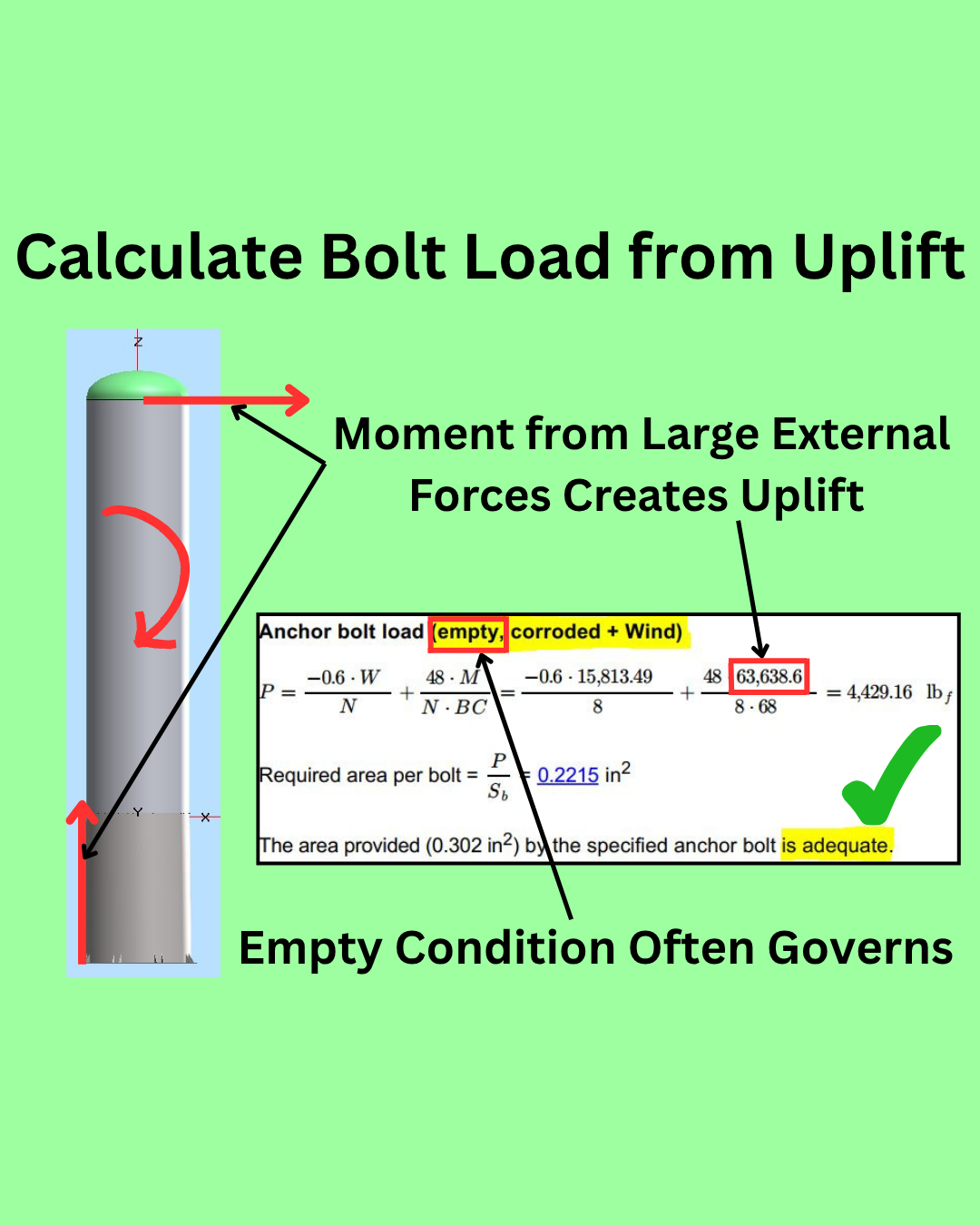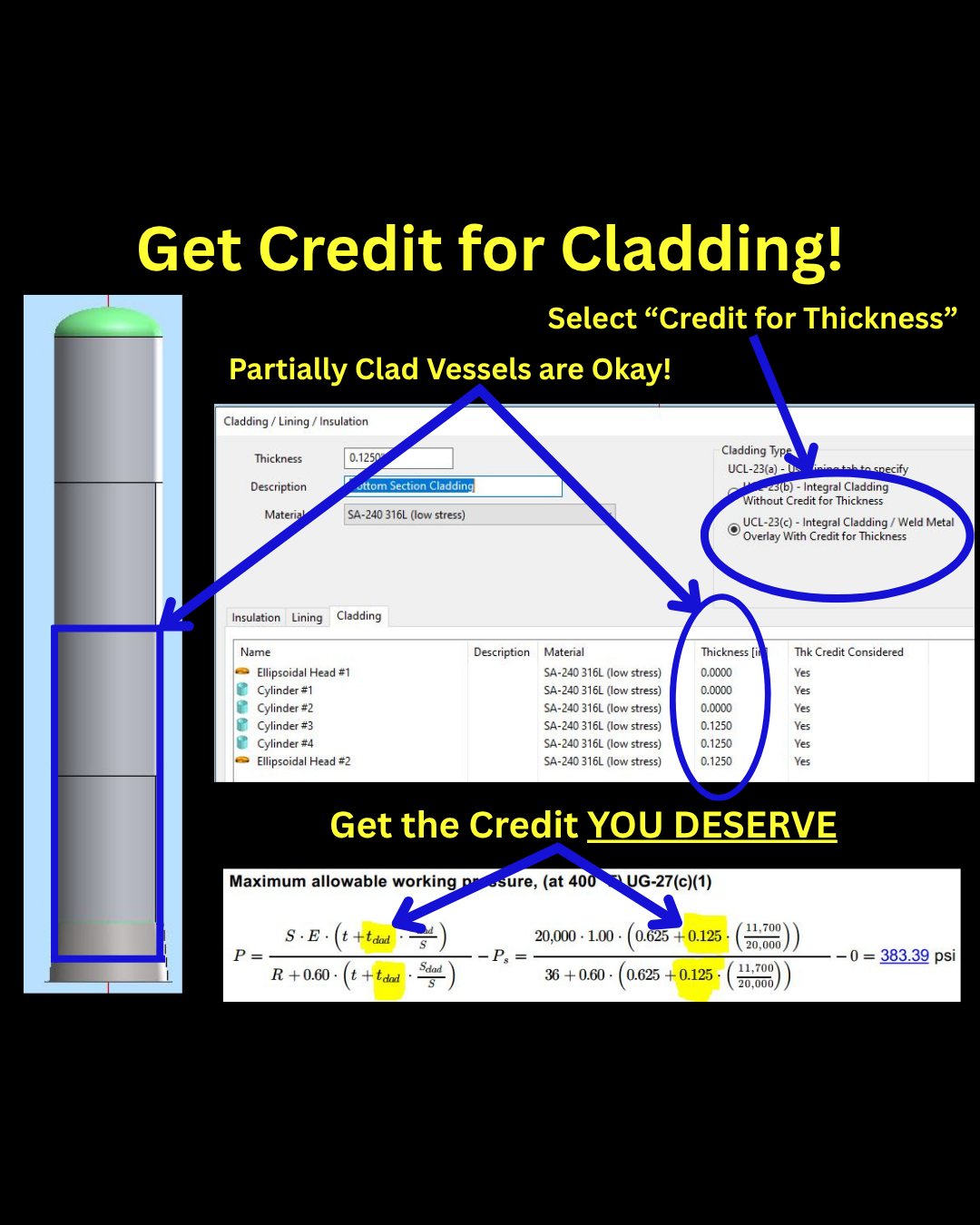Seamless Pipe with PWHT Designation
A Post Weld Heat Treatment (PWHT) designation for Seamless Pipe? Is that crazy?
It may not be standard procedure, but it isn’t crazy. I like to specify PWHT for seamless pipe materials when the pipe specification service calls for PWHT.
Let’s take a look at a common scenario where calling out Post Weld Heat Treatment (PWHT) designation for Seamless Pipe could have saved a big headache. In the example picture a new circuit was added to an existing circuit with a required PWHT designation due to service requirements. Since the seamless pipe did not have a PWHT designation, the welded pipe added during an expansion did not receive the required post weld heat treatment. The new pipe section that did not receive PWHT quickly experienced in-service issues.
Undocumented Equipment
Missing your name plate? Even worse, are you missing your design calculations?
No documentation? No problem!
I’m often asked questions about undocumented equipment when I’m on site for turnarounds. Owner/Operators would like to return undocumented equipment back to service but they do not have an engineering department with enough time to handle the complexities involved. Material identification, measuring dimensions and thicknesses, performing internal and external inspections, and providing detailed calculations adds way too much workload to think about handling undocumented equipment internally.
So it sits…and sits...
Sure, not all undocumented equipment is suitable to return to service, but wouldn’t you like to find out?
Metalmark Engineering helps you stay on top of OSHA’s Process Safety Management (PSM) program by providing missing design calculations, inspection reports, and detailed design drawings for your equipment without documentation.
Add Corrosion Allowance in Steam Service
Zero corrosion allowance for steam service? When did this design become normal?
Many times I see steam service equipment designed with a 0.25” (6 mm) nominal thickness and zero corrosion allowance. This occurs because steam service is often included in the lowest Risk Category in plants. Low Risk Category equipment will inherently have a zero corrosion allowance requirement. I’ve reviewed enough internal inspection reports for equipment in steam service to conclude that steam can be corrosive, especially in bottom head components.
Not including a corrosion allowance in the original design calculations often leads to dangerously thin components when real-world conditions eat through the zero corrosion assumption. Please reconsider designing with zero corrosion allowance for equipment in steam service.
Expensive Hydrotests
Sometimes performing the ASME Code required hydrotest is deemed too expensive so Owner/Operators skip it.
One factor that may raise the cost of hydrotesting is if the hydrotest pressure is much greater than the operating pressure. The higher hydrotest pressure may require the fabrication of single-use components, supplying a special set of gaskets, and another PCC-1 Appendix O calculation.
One of the sad realities of the extreme cost-cutting associated with modern manufacturing is the loss of basic design principles. I’ve noticed that performing proof tests and leak tests instead of ASME Code required hydrotests is becoming increasingly popular in new vessel construction.
Authorized Inspectors (AIs) often assume a shop hydrotest was performed and never check the U-Form notes that clearly states otherwise. The “what can I get away with?” mentality rewards design engineers with promotions while operator roles become increasingly dangerous.
Stop Designing with Deadlegs
Are you unintentionally adding deadlegs to your piping designs?
We all have hopes and dreams but your "future expansion” may actually be a major hazard due to the susceptibility of corrosion in these areas. Please be careful with piping headers and branched connections that are intentionally blinded off after construction to prepare for a future expansion. Many times the expansion plan never materializes and the associated deadleg is never properly accounted for in the site’s integrity program.
What’s wrong with deadlegs? They get hardly any flow and experience higher corrosion rates than the rest of the piping system.
CMLs Showing Equipment Growth
Ever plot CML thickness and notice your piping or equipment growing over time?
This “reverse corrosion” phenomenon sweeping inspection departments can defile your data and give false impressions of real metal loss and corrosion rates.
How common are growth readings for CMLs? VERY. In fact, during Jeff Goldstein, P.E.’s latest webinar “Rethinking Piping Inspection Locations” he discussed a site with 12,000 of 40,000 CML readings showing growth over the last CML reading. That is 30% of readings showing a growth rate instead of an expected metal loss/corrosion rate. What you decide to do with these growth readings will have a big impact on maintenance and inspection plans moving forward.
Maybe there was an undocumented piping or equipment replacement.
Maybe the measuring device was not properly calibrated when the operator took CML readings.
Maybe the CML readings were entered into software or spreadsheets incorrectly.
Maybe the CML readings were taken in the wrong location.
Please spend some time trying to understand what is causing growth readings and act accordingly.
B16.5 Blind Flanges as Reducers
Ever see ASME B16.5 blind flanges as reducers?
Just throw any pipe in a standard ASME B16.5 blind and you’re good-to-go, right?
No. That “standard” ASME B16.5 blind flange may not be “standard” once you decide to start drilling holes in it. Many times ASME B16.5 blind flanges used as reducers include pipes larger than allowed in B16.5 without a reinforcement calculation. Please make sure your facility has proper documentation for ASME B16.5 blind flanges used as reducers.
Verify Thicknesses Before Installing Equipment
Do you verify thicknesses before receiving your equipment?
The design calculations use NPS 8 Sch 120.
The fabrication drawings use NPS 8 Sch 120.
You received NPS 8 Sch 80 (XS).
So what happened? A drawing was misinterpreted and a fabrication mistake was made. Fabrication mistakes happen. Don’t compound those mistakes by not finding them until after installation. Using a 3rd party to verify that your as-built thicknesses meet or exceed your design thicknesses is a quick and important step you should implement before receiving your equipment to help improve your bottom line.
I like to use 3rd parties for thickness verification because they are excellent at communicating between fabricators and Owner/Operators during stressful projects. I trust Turnaround EPC for my 3rd party as-built thickness verification because of their excellent communication, fast service, and attention to detail.
Use ASME PCC-1 Appendix O to Fix Leaky Gaskets
Do you have an issue with leaky gaskets?
A lot of people message me complaining about leaky flange gaskets and wondering what kind of gaskets I recommend to help. The fact of the matter is that gasket quality and performance has never been better. I have found that many times the real problem is that the gasket was not considered during the design phase. Gaskets are an important part of flange design. Treat them that way.
Have you performed ASME PCC-1 Appendix O for your flanges?
An approach in ASME PCC-1 Appendix O can help you make sure your gaskets are being seated correctly. The gasket needs to be below the maximum permissible gasket stress, above the minimum seating gasket stress, and above the minimum gasket operating stress. In this example the minimum gasket operating stress is not being maintained at the operating condition.
Make sure you perform ASME PCC-1 next time you open up a pair of flanges.
Consider Longitudinal Stresses in Brittle Fracture Check
Do you consider longitudinal stresses when you check for brittle fracture?
I’ve had a lot of people asking me to check their hydrotest temperatures. A design where a governing longitudinal stress case was not considered in the Minimum Design Metal Temperature (MDMT) stood out to me.
Did you know that longitudinal stresses can govern the MDMT even if circumferential stresses govern the Maximum Allowable Working Pressure (MAWP)? Not checking the longitudinal stresses can lead to devastating results as the brittle mode of failure is swift and catastrophic. Always remember to consider longitudinal stresses in your brittle fracture check.
Move Data from U-Forms into Spreadsheets for AI
Are you ready for AI? Your data is not.
One of the big themes of Reuters Downstream 2025 was the use of AI in maintenance and inspection. I found the concept of using AI for predictive analytics in maintenance incredibly intriguing. However, let’s not pretend that your important data is in a format that AI can actually use. You need to digitize your data.
Are your U-Forms sitting in a filing cabinet somewhere?
How about the historical measured thickness data from internal inspections? Are those values just floating around in PDFs?
What about the interesting information found during external inspections? Repairs? Rerates? Derates? FFS assessments? Wouldn’t you want all of that data digitized in a way that makes it easy for AI to pull from?
We all know that AI is the future but AI is only as good as the data you are feeding it. Consider yourself behind if the items listed above are not in a usable, digital format.
Towers Falling During Postweld Heat Treatment (PWHT)
Have you seen a tower fall during Post Weld Heat Treatment (PWHT)?
As crazy as it sounds I’ve seen this occur when PWHT is applied around the circumferential seams of tall towers in the field. The solution is often even crazier as Owner/Operators prefer expensive materials analysis and complex FEA calculations over simple explanations. The fact is the tower behaved exactly as expected as it was never designed to take such loadings at temperature.
So what is actually happening?
1 - The Wind case was not properly considered by the design engineer
2 - The Wind case in the Empty condition was not calculated
3 - The much lower allowable stress in the material at temperature was not considered
4 - Wind loads during PWHT create a large moment that the material was not designed to resist
5 - DOWN IT GOES!!!
Do Not Use Calculation Exemptions on Important Process Nozzles
Do you use calculation exemptions on important process nozzles?
Yes, we all know nozzles under a certain size are exempted from the Division 1 nozzle area-of-replacement rules. That does not mean that you should use this exemption every time you can. Think very carefully about what each nozzle is used for and what the consequences of failure may be.
You may want to double-check exempted nozzles against another set of nozzle rules before finalizing your design. Are you around 90% of area-of-replacement? Fine. Are you around 50% of area-of-replacement like my example? You may want to add a little thickness to the nozzle. This is a bad place to try to save money on your design.
What if local corrosion is higher than the design corrosion?
There is no nozzle thickness to compensate for corrosion. Through wall corrosion is common.
What if nozzle loadings are higher than anticipated?
There is no extra thickness to handle pressure plus unexpected loadings.
What if an upset condition increases the process velocity?
There is no extra thickness to handle process erosion.
Derating for Process Safety Reasons
Why would anyone de-rate a pressure vessel or heat exchanger? What is the point of formally accepting less out of your equipment than it was designed for?
The simple answer is to reduce the operational risk at your facility by ensuring that pressurizing to the original Maximum Allowable Working Pressure (MAWP) is never attempted. The most common scenario I observe is when a design with no corrosion allowance does not align with measured in-service corrosion.
Many times pressure vessels and heat exchangers operate much lower than their ratings so de-rating causes no operational disruptions. Is there any equipment in your facility that could use a de-rate?
Be Careful with RT-4 Vessels in Corrosive Service
I think it’s time we talk about “RT 4” vessels and heat exchangers. I see them everywhere in corrosive processes and highly consequential service and I really wish I didn’t.
So what is “RT 4”? Well “RT 4” simply means that “RT 1”, “RT 2”, or “RT 3” do not apply. It does not mean anything else specifically about what kind of weld inspection was applied to the vessel.
How much radiography or other weld inspection is applied to a vessel marked “RT 4”? Some? None? I don’t know, but probably not a lot. I personally assume that no weld inspection was performed unless proven otherwise. This is where I have a problem with “RT 4” vessels and exchangers. I don’t feel comfortable placing vessels and heat exchangers in service without having some sort of assurance regarding the quality of the welds. When I uncover the root cause of unplanned shutdowns too many times these “RT 4” vessels are to blame.
I consider the cost of maintenance and inspection in my designs and I do not believe any money is saved in the long run by operating “RT 4” vessels.
Calculate Uplift for Bolting
Are your bolts designed to handle the uplift from moments caused by external forces like wind and seismic loads?
I commonly see equipment where only the operating case is checked and I’ve even seen cases where the bolt uplift calculation is ignored altogether. Don’t be fooled into ignoring this simple calculation as catastrophic bolt failure can cause severe damage to your equipment.
The empty condition often governs because process weight helps to prevent uplift. Please calculate all design conditions to determine the governing case.
Mechanical Credit for Cladding
Are you getting the credit you deserve?
The ASME Code allows you to take mechanical strength credit for cladding in design calculations. Most design engineers do not take credit for cladding and end up purchasing a thicker shell than necessary.
Take a look at this simple internal pressure with cladding example:
Design P = 350 psi (2413 kPa)
Shell Material = SA-516 70
Cladding Material = SA-240 316L
MAWP from shell component: 343 psi (2365 kPa)
MAWP from cladding component: 40 psi (276 kPa)
MAWP from shell plus cladding: 383 psi (2641 kPa)
Using only the shell component for mechanical strength fails at the Design Pressure of 350 psi (2413 kPa).
Using the shell plus cladding for mechanical strength passes at the Design Pressure of 350 psi (2413 kPa).
Calculate Required Slotted Bolt Hole Length
Can your saddle bolt holes handle the effects of thermal expansion in your equipment?
Bent saddles and sheared bolts from undersized slotted bolt holes pose a major operational risk that is often overlooked. It is much easier to design for thermal expansion before fabrication than it is to try to fix an inadequate slotted bolt hole length while in service. There is a simple calculation to determine if your slotted bolt hole length is enough to handle thermal expansion at design temperature.
Please review PIP VEFV1100 for more information regarding the design of supports and other attachments.
Check Water Temperature Before Hydrotest
Please check the water temperature before performing your hydrotest. It may be too cold!
Have you ever seen a pressure vessel or heat exchanger crack due to brittle fracture during hydrostatic testing? Thousands of hours spent on calculations, drawings, welds, and inspections down the drain. Then the root cause investigation results in more time and money lost.
Brittle fracture can occur during hydrostatic testing when the water temperature used in the hydrotest is too close to the Minimum Design Metal Temperature (MDMT) of the material. This means that your equipment can pass the design MDMT calculations and still experience brittle fracture during hydrostatic testing. This simple temperature check is often missed and can lead to devastating results.
Please review UG-99 for more information regarding hydrostatic testing.
LWN Forged Flanges Required Nozzle Calculations
Are you performing the required calculations for your LWN forged flanges?
LWN forged flanges are popular among Owner/Operators because the ASME Codes offer some calculation exemptions. However some Owner/Operators have started to believe that LWN forged flanges are exempt from all calculations. This is a dangerous trend as LWN forged flanges are not automatically acceptable at their designated ASME B16.5 flange pressure rating classification. Yes, LWN forged flanges do have some similar exemptions as ASME B16.5 flanges but a full nozzle calculation must still be performed at the nozzle-to-vessel intersection.











